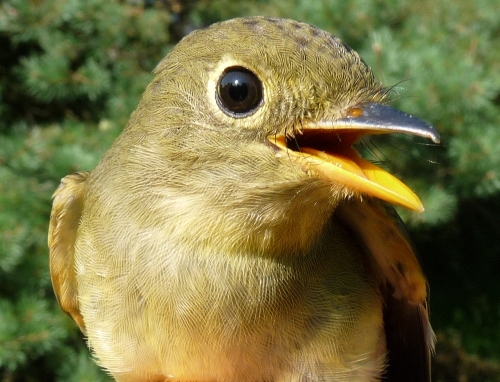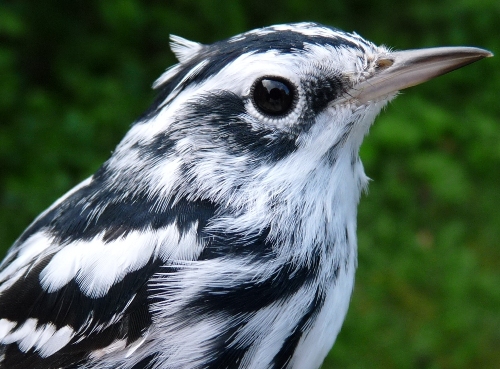|
Week 4: August 22-28, 2009 |
Welcome
to the McGill Bird Observatory weekly report.
Click here for a complete listing of our archives.
Comments or
questions are welcome at "mbo AT migrationresearch.org".
|
PICTURE
OF THE WEEK: |
|

It has been said that "cuteness" can be a factor in helping distinguish among eastern
Empidonax flycatchers. While Least Flycatcher is often considered to be at the top of
that list, this Yellow-bellied Flycatcher is making a strong case for his/her own kind. And
with Yellow-bellied Flycatcher making its first ever entry on the list of top ten species
banded at MBO
for the week, it's an even more appropriate choice for our feature photo.
(Photo by Marcel Gahbauer)

|
MBO
gratefully acknowledges the financial support
provided for the 2009 Fall Migration Monitoring
Program by TD Friends of the Environment Foundation
|
|
|
|
THIS WEEK |
THIS FALL |
2009 TOTAL |
SITE TOTAL |
|
# birds (and species) banded |
196 (33) |
756 (54) |
1760 (77) |
20681 (105) |
|
# birds (and species) repeat |
40 (18) |
142 (25) |
421 (40) |
3768 (66) |
|
# birds (and species) return |
2 (2) |
14 (11) |
132 (29) |
586 (35) |
|
# species observed |
78 |
107 |
155 |
198 |
|
# net hours |
533.0 |
2042.7 |
5401.2 |
35866.5 |
|
# birds banded / 100 net hours |
36.8 |
37.0 |
32.5 |
57.6 |
|
|
Note: table does not include nocturnal banding (owls) |
|
Banders-in-charge: Simon Duval, Marcel Gahbauer, Gay Gruner
Assistants: Isabelle Bisson, Marcelo Brongo, Jean Demers, Barbara Frei, Tiffany Gilchrist, Bana Hamze, Marie-Anne Hudson, Kristen Keyes, Barbara and Don MacDuff, Francine Marcoux, Chris Murphy, Clémence Soulard, Alex Stone, Rodger Titman
Notes: It's hard to believe, but we've already completed nearly a month of fall migration monitoring. On the whole, numbers this week were rather similar to last week, and again they were fairly high compared to other years at the same time, most similar at this point to the very productive start to 2006. With a cold front moving through the region on Wednesday night, the final two days of the week did begin to show a bit of a change in the mix of migrants present.
We added another 8 species to our checklist of birds observed this fall, in chronological order: American Black Duck, Wilson's Warbler, Broad-winged Hawk, Herring Gull, Black-throated Green Warbler, Great Horned Owl, Least Sandpiper, and Blackburnian Warbler. Most of these were chance sightings - American Black Ducks, Least Sandpipers and Herring Gull flying overhead, a single Wilson's Warbler caught on Sunday morning, a single early morning series of hoots from a Great Horned Owl, and lone Broad-winged Hawk and Blackburnian Warbler courtesy of census. Out of these, the Black Duck, Great Horned Owl, and Least Sandpiper were observed for the first time this year. On the banding front, the Wilson's Warbler was the first of the fall, along with Blue Jay, Black-throated Green Warbler, and Sharp-shinned Hawk; the latter two were banded for the first time in 2009.

Our fascination with American Redstarts continues. This particularly striking after-hatch-year male had the darkest chest patch we've seen yet - "chrome orange".
(Photo by Simon Duval)

While some warblers have been relatively scarce so far this fall, the Black-and-white has actually exceeded expectations, showing up in the top half of our "top ten banded" list for two weeks in a row now.
(Photo by Marcel Gahbauer)
|
Song Sparrows extended their dominance of the banding list to a fourth straight week - the first time we have had any species on top right throughout August. This week they had a commanding lead over American Redstart and Common Yellowthroat, which filled the two runner-up spots for a second week in a row. Beyond that, however, there were a lot of changes, with only two of the remaining eight species (we had a tie) carry-overs from last week: Black-and-white Warbler and Red-eyed Vireo. Top newcomers were Black-capped Chickadee (perhaps foreshadowing what we expect might be a busy fall for them) and Magnolia Warbler - which for the past four years had been the top species for week four. Others added to the list in a four-way tie for eighth place were Cedar Waxwing, Ovenbird, Tennessee Warbler, and Yellow-bellied Flycatcher.
There was less change in the list of species most frequently observed, with only American Redstart being added in a tie for ninth, in place of House Wren last week. Others shuffled around the list a bit, with American Crow making it to the top spot for the first time this fall, and last week's top three each sliding down one place accordingly. Red-winged Blackbirds made the most noticeable drop down the list, and even so were retained only thanks to a large flock that roosted in Stoneycroft Pond one night this week and took off while the nets were being put up for the morning.
This week’s top 10 [last week's rank in brackets]
# individuals banded |
mean # individuals observed daily |
1. Song Sparrow (30) [1] |
1. American Crow (21.7) [6] |
2. American Redstart (18) [2] |
2. Black-capped Chickadee (19.7) [1] |
3. Common Yellowthroat (16) [3] |
3. Cedar Waxwing (19.6) [2] |
4. Red-eyed Vireo (14) [5] |
4. American Goldfinch (16.3) [3] |
5. Black-capped Chickadee (11) [-] |
5. Song Sparrow (10.7) [5] |
5. Magnolia Warbler (11) [-] |
6. Gray Catbird (8.4) [10] |
7. Black-and-white Warbler (8) [3] |
7.American Robin (8.0) [7] |
7. Ovenbird (8) [-] |
8. Red-winged Blackbird (7.3) [4] |
9. Yellow-bellied Flycatcher (7) [-] |
9. American Redstart (6.9) [-] |
9. Cedar Waxwing (7) [-] |
9. Common Grackle (6.9) [9] |
|
With seasonal temperatures in the long-range forecast, we're eager to see whether our traditional rich mix of warblers will move through MBO over the next couple of weeks...
|

This fine fellow is a perfect example of how it pays off for volunteers to always keep searching for observations everywhere - Clémence discovered this relatively hefty-looking gray tree frog sitting in the 'doorway' of the bluebird/swallow nest box on our windmill, not just once, but on three separate days ... and as far as we know, nobody else spotted him/her until she pointed it out! We need that sort of eagle-eyed spotting throughout the season to ensure we get good documentation of all the species less likely to be encountering any of the nets - birds and otherwise!
(Photo by
Marcel Gahbauer)

It's not often in fall that Chestnut-sided Warblers live up to their name - but this handsome after-hatch-year male did (though even he is doing a relatively good job of concealing most of his chestnut at this time of year).
(Photo by Marcel Gahbauer)

The first raptor of the season (in the nets) is always a highlight. This year it was this hatch-year female Sharp-shinned Hawk that took those honours on Tuesday morning - a bit surprising as we had been watching Cooper's Hawks and Merlins quite near the nets that morning and in previous days, but haven't been able to catch them yet.
(Photo by Marcel Gahbauer)
|







